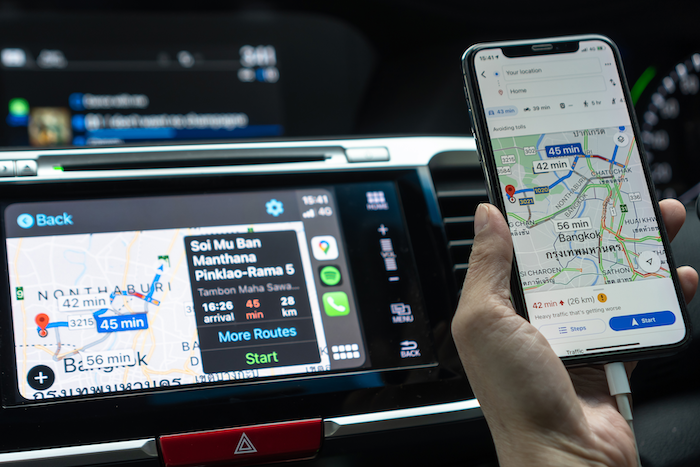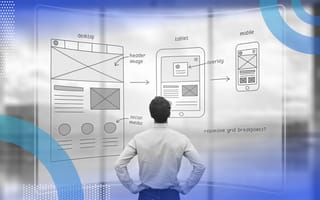User interface (UI) design is an essential aspect of software and digital device design. Good UI design enhances the user experience, improves productivity and enables users to interact with technology seamlessly. As technology continues to develop, UI designers must keep up with the latest trends and technologies to create interfaces that meet the needs and preferences of users. This process includes staying up-to-date with advancements in mobile design, responsive design, voice interfaces and artificial intelligence (AI).
UI designers must also take into account the needs of diverse user groups, including those with disabilities, and create interfaces that are accessible and inclusive. By incorporating elements of good UI design, such as consistency, clarity and responsiveness, designers can create interfaces that enhance the user experience and drive user engagement.
User interface design has two parts. First, we must understand what a user interface (UI) is, and then, we can talk about the interface design. So what’s a user interface?
What Is a User Interface (UI)?
The UI is how the user interacts with the computing device to solve problems. The UI can frustrate users but the designer is there to make the interface usable, accessible and less frustrating. The UI is changeable so there are always opportunities to help make it better alongside a designer.
However you interact with a computational device is a user interface. The browser you’re reading this article on? User interface. The printer screen you had to interact with to print this article out? User interface. The smart phone home screen from which you’re trying to ignore that notification? User interface.
Types of UI Designs
There are various types of UI designs, each with its unique characteristics and applications.
Some of the most common types include:
- Graphical User Interface (GUI): This is the most widely used type of UI design, which uses visual components such as icons, menus and buttons to enable user interaction with software applications or digital devices.
- Command-Line Interface (CLI): This type of UI design requires users to type in commands to interact with technology. It’s most often used by programmers and system administrators to perform complex tasks.
- Natural Language Interface (NLI): This type of UI design uses natural language processing (NLP) technology to enable users to interact with technology using voice commands or written text.
- Menu-Driven Interface: This type of UI design leverages menus to steer the user and is mostly seen in terminal-driven applications.
What Is a UI Designer?
When a team builds a product, someone with the word “designer“ in their title is usually in charge of the user interface. If there is no designer, the task will often fall to a product manager or a front-end developer. The designer is here to make the interface usable for the target customer. The designer also makes the UI accessible so the user can get the most out of the software. Finally, this person’s job is to make the UI less frustrating so people will actually use it.
The person or team responsible for the UI often uses research to help improve the design. Sometimes this comes in the form of usability testing, user interviews or just looking at how users interact with the product through software that tracks how users accomplish their goals.
Elements of Good UI Design
Good user interface design helps the user get what they want without exposing the user to risk.
Whenever you’re using software, you do so through an interface that allows you to interact with the code that helps you complete a task. Instead of working with source code and a compiler, a well-designed user interface makes the task easy for both you and the computer.
An effective UI design is important because computers will process the instructions you give them, whether you know what they mean or not. Computers don’t know if you always intend what you input. If there are no guardrails (which is something a good user interface can offer), anything is possible. I’m speaking from experience; when I was four, I accidentally formatted my father’s hard drive because I didn’t understand the UI (in this case, CLI).
Good UI design incorporates several elements that enhance the user experience.
- Consistency: Consistency in design ensures that users can navigate through different screens and components of the interface easily without getting confused.
- Clarity: Clarity in design ensures that the interface is easy to understand and navigate, even for first-time users.
- Responsiveness: A responsive interface ensures that users can interact with technology in real-time, without experiencing lags or delays.
Google’s front page is a great example of a simple, effective UI. You know exactly what you’re there to do: search. Almost nothing else exists on the page to distract you and you can’t break Google no matter what you input on this screen.

Common Examples of Good UI Design
Apple iPhone
The iPhone’s interface is intuitive, responsive and easy to use. It’s simple design and navigation make it easy for users to access various features. The UI design also leaves room for iPhone power users to access hundreds of features, but if you just need to make a call, you just need a few on-screen buttons.

Google Maps
Google Maps’ interface is user-friendly, with clear directions, icons and buttons that enable users to navigate and explore different locations. Much like the iPhone, Google Maps has a suite of features, however, if you just need to get to where you’re going, all you have to do is put in an address.

UI vs. UX
UX is short for user experience. Let’s go to Interaction Design Foundation (IxDF) for a definition:
User experience (UX) design is the process design teams use to create products that provide meaningful and relevant experiences to users. This involves the design of the entire process of acquiring and integrating the product, including aspects of branding, design, usability and function.
Although UI is about how the human interacts with the product, the UX looks at a user’s holistic experience with the product. UI is a part of that experience, so you can think of UI as one a part of the larger UX puzzle.
Benefits of UI Design
Let’s go back to why you’re here. How does UI affect your work and who is usually in charge of making it?
Well, the UI is how your users will go about actually tackling the problem your software exists to solve. When a UI is built well, it offers fewer ways for the user to get stuck. Good UI is accessible to a wide range of skill levels and you can see metrics like net promoter score (NPS) go up as users find themselves interacting with the product with ease. High NPS can be a signal to leadership that the work you are doing is improving the overall user experience.
Note: NPS tends to be an executive friendly metric, not necessarily one that rates the experience. It’s worth using the positive number for storytelling and leveraging the zeroes you receive to help you find the trouble spots.
Challenges of UI Design
Design Complexity
Designing a UI that is both visually appealing and functional can be a complex process that requires a deep understanding of user needs and preferences. Creating the simplicity of the Apple and Google examples above takes thousands of iterations and millions of hours of testing what users do and don’t do.
Device Compatibility
UI designers must ensure that their designs are compatible with various devices including mobile devices, tablets and desktop computers. Take the Apple example. There are several different versions of an iPhone that are updated at once, with different screen sizes, storage capacities and processors. Those concepts have to be accounted for so that the iPhone “just works.”
Future Prospects of UI Design
The future of UI design looks promising, with new technologies such as virtual reality (VR) and augmented reality (AR) creating new opportunities for designers to create innovative interfaces.
However, as technology continues to change, UI designers will need to stay up-to-date with the latest trends and technologies to create interfaces that meet the needs of users.
As our technology shifts to different types of experiences, we’ll need to understand how our brain interprets and engages with that technology. For instance, in virtual reality, devices like Meta’s Oculus takes users into different worlds where they find themselves in spaces that are immersive. This is a completely different kind of user interface than you might experience by typing into a word processor or scrolling on your iPhone. Or think about augmented reality games like Pokémon GO that bring the user outside and combine the real world with a digital overlay. These applications will require UI designers to continue researching how users want (and need) to interact with these innovative interfaces.





